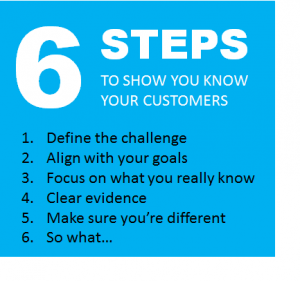 Six steps to show you know
Six steps to show you know
It’s surprising sometimes just how little or perhaps irregularly we test our assumptions about what we think we know or don’t know about our customers. And, it’s sometimes worthwhile just to step back and apply a few simple tests to see if we’re clear about what we do or don’t know.
There are perhaps six steps that can be applied to test if you know what customers want. The tests are not rocket science and most competent markets know the rules, but just sometimes a few vital assumptions slip through the net that shouldn’t. In practice the tests are quite cost effective and help avoid disproportionally higher rework or failure costs later on.
The six steps can be used to assess customers needs, wants, beliefs, assumptions and fears. We’ve used these in workshop sessions to help people work quickly through issues, understand specific needs and then use other ‘follow-on’ tools to develop effective product, service and value propositions.
The tests are easy to apply by almost anyone and can have some interesting outcomes. It’s best to use the tests with diverse groups of people, a broad coalition of people with a range of skills and capability (technologists, marketers, sales), this adds richness and alternative viewpoints into the discussion, and wherever possible involve customers and suppliers, directly or through co-creation, collaboration and ideation.
Step 1: definition
Clearly explain in a line or two exactly what the customer needs, wants, believes, assumes or fears is (the challenge). Make sure you’re not talking about your product or service benefits or your perception, but about how the customer sees things (outside in perspective), put yourself in the ‘customers shoes’. You may want to identify several challenges, but you will have to work through each one in turn and try not to combine challenges as that just confuses things. The key here is to be precise about the challenge are you trying to meet. Once you have clearly defined the challenge move to step 2.
Step 2: alignment
Review the challenge. Do you think you can do anything about this? Is it aligned in any way to your business, brand or marketing objectives? Do your internal attitudes and behaviours suggest you could meet the challenge? Would the organisation give this priority over other things? If the answer to these questions is no, then you probably shouldn’t trying to help here. If, on the other hand the answer is yes: clearly explain how your plans, attitudes and behaviours will help solve the challenge for the customer and how well your aligned to potential customer outcomes, the closer the fit the better.
Step 3: Focus
What do you really know about the customer and specific markets or segments that could benefit from you meeting the challenge? Explain clearly, why these customers in particular will benefit, how will the benefits be delivered and when. Do you need partners to fulfil your promise? If so, which ones and are they aligned with you and the customer challenge? You may think you can meet the challenge but if you are not clear about which segments will benefit then there is little point in moving forward.
Step 4: Clarity
Do we have clear evidence, data and information to back up our hypothesis that specific segments and customers want the challenge to be resolved. Do customers think it’s important? Have we made any assumptions that need to be tested with customers? Do we have evidence that we can resolve the challenge better than our competitors? Ensure you know and can prove that enough customers agree with you and that you can outperform the competition.
Step 5: Differentiation
Now that we understand our customers challenge and the market, exactly what will make us different? Develop 3-5 unique and compelling differentiators (product, feature, service, value, market positioning, gap in the experience…) that customer will value and explain why these individually and collectively will provide competitive advantage in the market.
Step 6: So what…has anything changed
What are we going to do next? What are the 3-5 key market actions (things we will do in the market) and how do we expect customers to react them? What will they do differently as a consequence of our actions, will they change their attitudes and behaviours and if so how? What do we need to change internally (operations) to ensure we can fulfil our promises? What will our competitors do and how do we think they will react, will they change their attitudes and behaviours as a consequence? What are our counter moves?